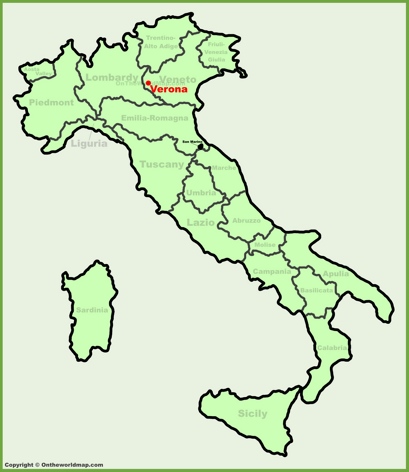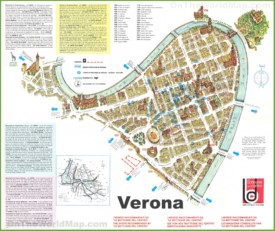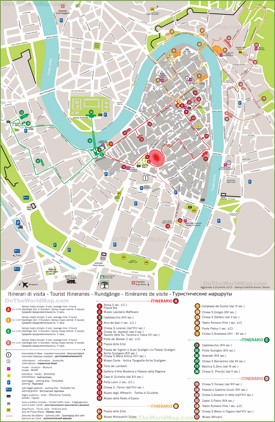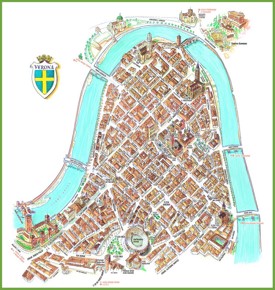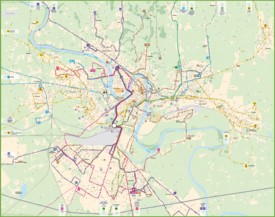Verona Maps
Online Map of Verona
About Verona
Verona is a historic city located in the Veneto region of northern Italy. It is situated along the Adige River, approximately 30 kilometers east of Lake Garda. The city covers an area of about 206 square kilometers. As of the latest estimates, Verona has a population of approximately 255,670 residents. The city is characterized by its blend of historical charm and modern urban life, attracting both locals and tourists.

Verona has a rich history that dates back to Roman times. It was established in the 1st century BC and became an important Roman settlement. The city's strategic location made it a vital hub for trade and military operations. During the Middle Ages, Verona flourished under the rule of the Scaliger family, who left a significant architectural legacy. The city is also famously associated with William Shakespeare's play "Romeo and Juliet."

The Verona historic center is a UNESCO World Heritage Site, featuring numerous landmarks:
The Verona Arena is a Roman amphitheater located in Piazza Bra, built in the 1st century AD. It is one of the best-preserved ancient structures of its kind and is renowned for its remarkable acoustics. Originally used for gladiatorial contests and other public events, the arena now hosts large-scale opera performances and concerts during the annual Verona Opera Festival.

Piazza delle Erbe is the oldest square in Verona, historically serving as the town's forum during the Roman era. It is surrounded by medieval buildings, including the Torre dei Lamberti, Casa dei Mercanti, and the frescoed Mazzanti Houses. The square features the Madonna Verona fountain, a Roman statue dating back to 380 AD, and is a vibrant marketplace with numerous cafes and shops.



Juliet's House (Casa di Giulietta) is a popular tourist attraction linked to Shakespeare's fictional character Juliet Capulet from "Romeo and Juliet." The 13th-century building features a small museum and the famous balcony where Juliet is said to have been serenaded by Romeo. Visitors often leave love notes on the walls of the courtyard and touch the bronze statue of Juliet for good luck.

Castelvecchio is a medieval castle built in the 14th century by the Scaliger dynasty. It is located on the banks of the Adige River and features a fortified bridge, the Ponte Scaligero. The castle now houses the Castelvecchio Museum, which contains an extensive collection of medieval, Renaissance, and modern art, including works by artists such as Pisanello and Tintoretto.
Piazza dei Signori, also known as Piazza Dante, is a historic square that served as the political and administrative center of Verona. It is surrounded by important buildings such as the Palazzo della Ragione, the Loggia del Consiglio, and the Palazzo del Podestà. A statue of the poet Dante Alighieri, who lived in Verona during his exile, stands prominently in the square.

Basilica of San Zeno Maggiore is a Romanesque church dedicated to Verona's patron saint, Zeno. Built between the 9th and 12th centuries, it is renowned for its stunning bronze doors, intricate facade, and the altarpiece by Andrea Mantegna, depicting the Madonna and Child with Saints. The church's crypt is believed to be the setting for the marriage of Romeo and Juliet.
Torre dei Lamberti is an 84-meter high tower offering panoramic views of Verona. Construction of the tower began in the 12th century and was completed in the 15th century. Visitors can climb the stairs or take an elevator to the top for a breathtaking view of the city and its surroundings.
The Giardino Giusti is a Renaissance garden located behind the Palazzo Giusti. Created in the late 16th century, the garden is famed for its manicured hedges, statues, and fountains. It offers a peaceful retreat and a picturesque view of Verona from its elevated terrace.
Santa Maria Antica is a small Romanesque church known for its Scaliger Tombs, the elaborate Gothic funerary monuments of the Scaliger family. The church dates back to the 7th century and served as the private chapel of Verona's ruling family during the Middle Ages.
Ponte Pietra is a Roman arch bridge that crosses the Adige River. Originally constructed in 100 BC, it has been rebuilt several times due to flood damage and war destruction. The bridge offers scenic views of Verona and is a testament to the city's ancient engineering prowess.


Verona has a rich cultural scene, with numerous theaters, museums, and galleries. The city hosts several annual events, including the Verona Opera Festival held in the Arena, attracting international audiences. Verona's cultural heritage is also reflected in its culinary traditions, with local specialties such as risotto all'Amarone and pandoro.
Verona's economy is diverse, with strong sectors in agriculture, manufacturing, and services. The region is known for producing high-quality wine, particularly Valpolicella and Amarone. The city also has a significant industrial base, with industries including machinery, textiles, and food processing. Tourism plays a crucial role in the local economy, attracting visitors to its historical sites and cultural events.
The University of Verona, established in 1982, is a prominent educational institution offering a wide range of undergraduate and postgraduate programs. The university is known for its research activities, particularly in the fields of economics, law, and medicine.
Verona is well-connected by various modes of transportation. The city has an efficient public transport system, including buses and a railway network that links it to major Italian cities such as Milan, Venice, and Rome. Verona Villafranca Airport provides domestic and international flights, enhancing the city's accessibility.


The Facts:
Region: Veneto.
Province: Verona.
Area: 79 sq mi (206 sq km).
Population (2024): 255,670[1].
References
1. Demografia in cifre. Italian National Institute of Statistics.Maps of Italy
Cities of Italy
Cities of Italy
Regions of Italy

